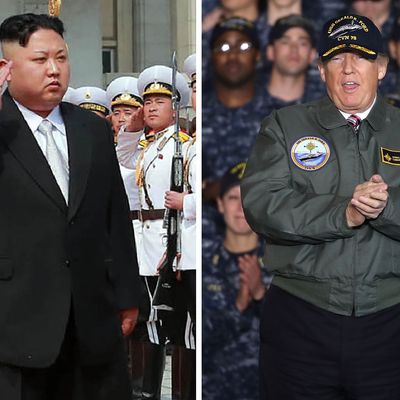
World War III did not break out on the Korean Peninsula over the weekend. The North Korean regime did not test a nuclear weapon on a major holiday given to bellicose military displays. The Trump administration did not use the aircraft carrier group it sent to the region to launch a preemptive military strike that might set off full-scale — even nuclear — war. But the stressful episode wasn’t a total waste of adrenaline — it offers Korea watchers and Trump watchers alike a few key lessons about the predictable unpredictability underlying this extremely thorny international crisis.
Lesson No. 1: There will be another crisis soon, and Washington needs to know that. In the case of North Korea, which thrives on anniversaries and embarrassing the government in Seoul, there are not many real surprises. Korea experts can predict “crises” with great accuracy — is there a North Korean anniversary on the calendar? A high-ranking visitor to Seoul that the North can embarrass? An allied military exercise the North can complain about? The weekend’s failed missile launch, for example, took place shortly after the birthday of regime founder Kim Il-sung, and overlapped with Vice-President Pence’s visit to Seoul. But failures like that don’t cause the regime to change course. It won’t this time either. Pyongyang promptly promised “weekly” missile launches. Launching missiles at Syria, dropping the Mother of All Bombs in Afghanistan, and sending aggressive tweets from Mar-a-Lago makes for good theater on the U.S. side, but nothing fundamental has changed.
Lesson No. 2: North Korea is only getting scarier. Little by little, the regime is advancing its ability to deliver a nuclear warhead to its regional rivals — and eventually to the continental United States. The mocked-up missiles on display in last Saturday’s Pyongyang parade seem designed to communicate, as analyst Melissa Hanham told the Washington Post, “They can launch a lot more of these things in quick succession.” That matters because Pyongyang has staked the regime’s survival on the idea that it is capable of preempting a foreign attack (like, for example, missiles launched from a U.S. aircraft carrier) with a devastating nuclear blow. Appealing as preemption sounds, the notion of a nuclear strike on Seoul and the tens of thousands of American troops along the demilitarized zone is a very strong disincentive. Pyongyang explicitly says that it aims to build a weapon that can strike the Western U.S., to make that disincentive even stronger. There’s nothing on the horizon that looks like it will do much to slow, much less reverse, North Korea’s nuclear progress.
Lesson No. 3: Pretensions and theatrics aside, Trump is sticking with the same North Korea policy that’s been in place for years. The Trump team has not, in fact, come up with a new alternative to the Korea policy of the last three U.S. administrations. Its two core elements are first, exert strenuous military, political, and economic pressure on the regime; and second, demand that Pyongyang give up nuclear weapons entirely. Given that the alternative seemed to be a push for a preemptive U.S. attack, this is good news. Every administration since Bill Clinton’s has considered a preemptive attack on the North’s nuclear program, and each has reached the same conclusion: the likelihood of spiraling into full-on conventional or even nuclear war, leading to massive civilian casualties, and even China’s entry into the conflict to ensure the North’s survival, is just too high.
Lesson No. 4: But there’s a hint that Trump might be open to a new approach in the future. The existing, bipartisan policy toward North Korea has an enormous, acknowledged problem: Pressuring the North to give up its nuclear program has incontrovertibly failed. Under each succeeding administration the program has instead accelerated. The policy hasn’t been much more successful when it comes to changing Pyongyang’s behavior abroad, or its ill-treatment of its own people.
The Trump team has said it plans to exert “maximum” pressure on the regime. And while that rhetorical innovation is unlikely to be the key that unlocks the problem, Korea watchers were intrigued to see in the administration’s policy statement last week a mention of “engagement” as another goal. An unexpected group of experts — including such senior figures as former Secretary of Defense William Perry and Bush 43 official Richard Haas — believe that combining pressure with talks, narrowly defined with clear carrots and sticks and verification measures to cope with the North’s dismal record of cheating on past deals, would be more effective than demanding Pyongyang denuclearize. By accepting — even implicitly — the North’s nuclear-power status, they argue, Washington gives itself chips to bargain with other than the carrier group Trump is currently using. (And yes, you can use military power as a bargaining chip, but the risks of misperception are strong even between highly predictable actors. Which isn’t what we’ve got here.)
At some points on Monday it sounded as if Rex Tillerson’s State Department agreed, with a senior official telling reporters that the only precondition for talks would be “any kind of possibility that they would be rolling back their program.” The idea of a hard-edged negotiation might flatter Trump’s sense of his deal-making abilities; it may also appeal to the pragmatists in his circle of military advisers. He would be able to claim a major coup in partnering with China, as well. However, it is anathema to longstanding mainstream GOP views, toward which Trump has recently pivoted on a variety of security issues. Among other problems, it makes for awkward comparisons with the Iran nuclear deal the GOP loves to hate. So what exactly did the administration mean by “engagement”? It seems too soon to imagine Jared Kushner in the stands at a North Korean military parade. But I wouldn’t rule it out.
Heather Hurlburt (@natsecHeather) directs New America’s New Models of Policy Change initiative and has held foreign policy positions in Congress, the White House and State Department.





























